Corporate Governance Executive Summary 2022
VerifiedAdded on 2022/09/17
|16
|3365
|21
AI Summary
Contribute Materials
Your contribution can guide someone’s learning journey. Share your
documents today.
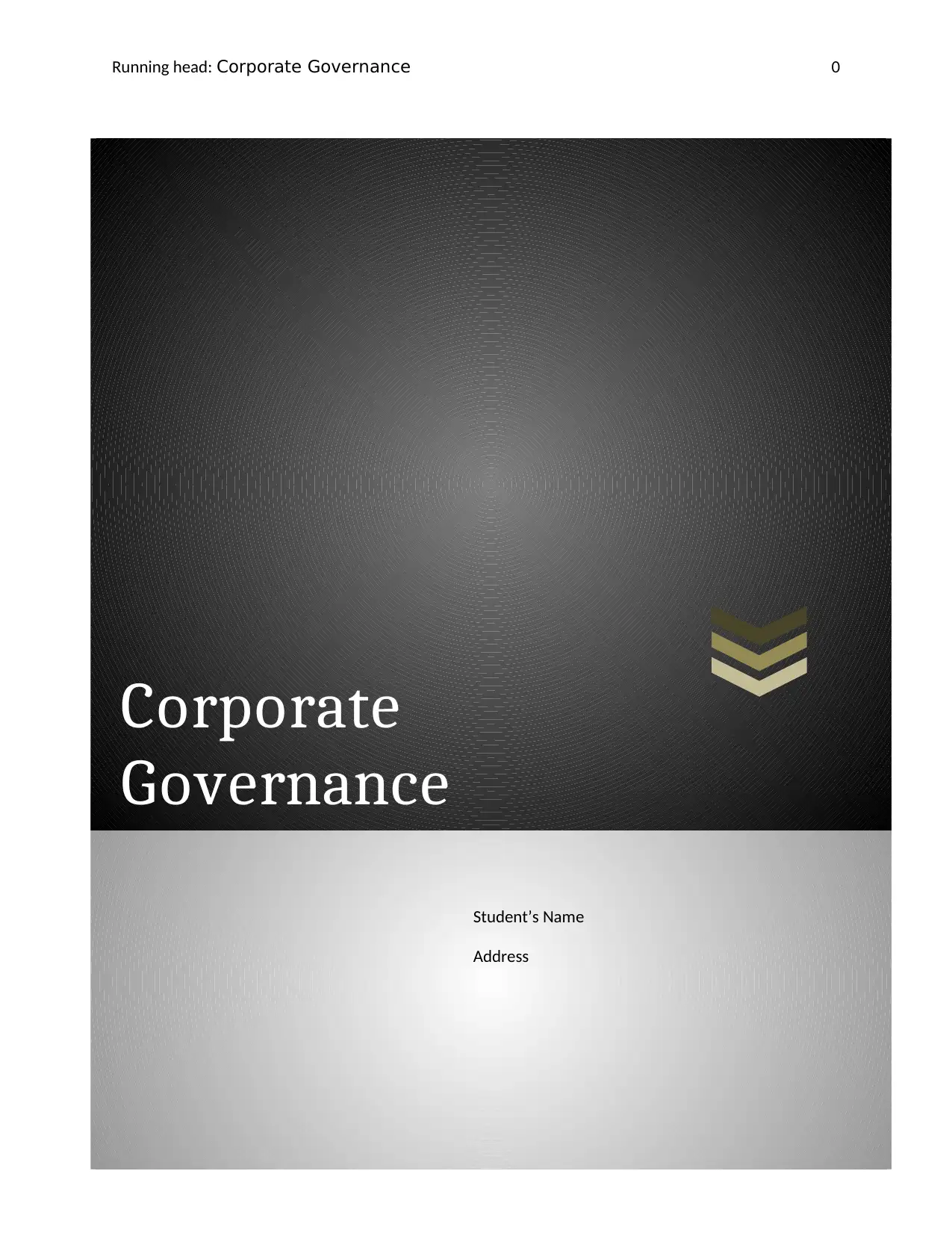
Corporate
Governance
Running head: Corporate Governance 0
Student’s Name
Address
Governance
Running head: Corporate Governance 0
Student’s Name
Address
Secure Best Marks with AI Grader
Need help grading? Try our AI Grader for instant feedback on your assignments.
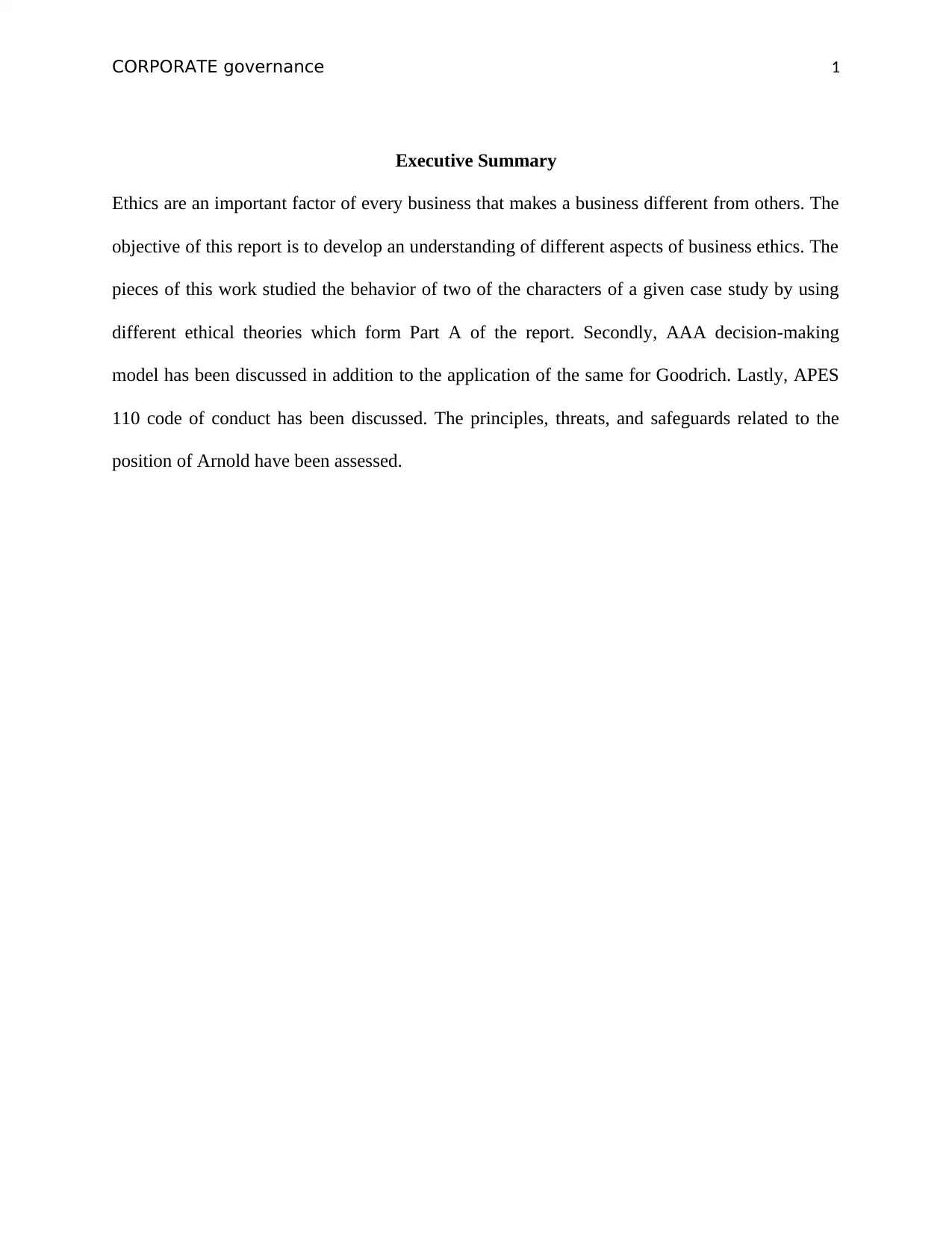
CORPORATE governance 1
Executive Summary
Ethics are an important factor of every business that makes a business different from others. The
objective of this report is to develop an understanding of different aspects of business ethics. The
pieces of this work studied the behavior of two of the characters of a given case study by using
different ethical theories which form Part A of the report. Secondly, AAA decision-making
model has been discussed in addition to the application of the same for Goodrich. Lastly, APES
110 code of conduct has been discussed. The principles, threats, and safeguards related to the
position of Arnold have been assessed.
Executive Summary
Ethics are an important factor of every business that makes a business different from others. The
objective of this report is to develop an understanding of different aspects of business ethics. The
pieces of this work studied the behavior of two of the characters of a given case study by using
different ethical theories which form Part A of the report. Secondly, AAA decision-making
model has been discussed in addition to the application of the same for Goodrich. Lastly, APES
110 code of conduct has been discussed. The principles, threats, and safeguards related to the
position of Arnold have been assessed.
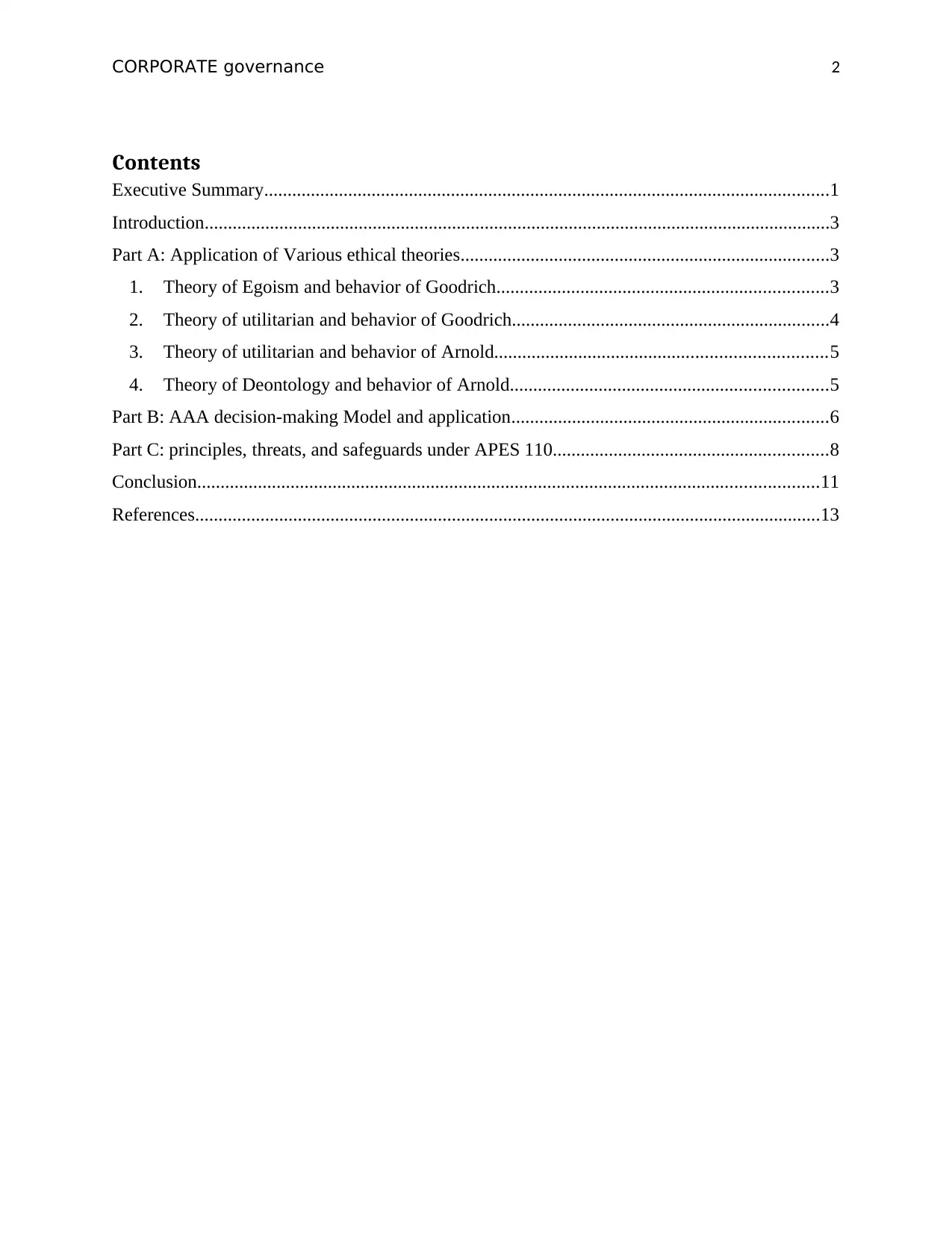
CORPORATE governance 2
Contents
Executive Summary.........................................................................................................................1
Introduction......................................................................................................................................3
Part A: Application of Various ethical theories...............................................................................3
1. Theory of Egoism and behavior of Goodrich.......................................................................3
2. Theory of utilitarian and behavior of Goodrich....................................................................4
3. Theory of utilitarian and behavior of Arnold.......................................................................5
4. Theory of Deontology and behavior of Arnold....................................................................5
Part B: AAA decision-making Model and application....................................................................6
Part C: principles, threats, and safeguards under APES 110...........................................................8
Conclusion.....................................................................................................................................11
References......................................................................................................................................13
Contents
Executive Summary.........................................................................................................................1
Introduction......................................................................................................................................3
Part A: Application of Various ethical theories...............................................................................3
1. Theory of Egoism and behavior of Goodrich.......................................................................3
2. Theory of utilitarian and behavior of Goodrich....................................................................4
3. Theory of utilitarian and behavior of Arnold.......................................................................5
4. Theory of Deontology and behavior of Arnold....................................................................5
Part B: AAA decision-making Model and application....................................................................6
Part C: principles, threats, and safeguards under APES 110...........................................................8
Conclusion.....................................................................................................................................11
References......................................................................................................................................13
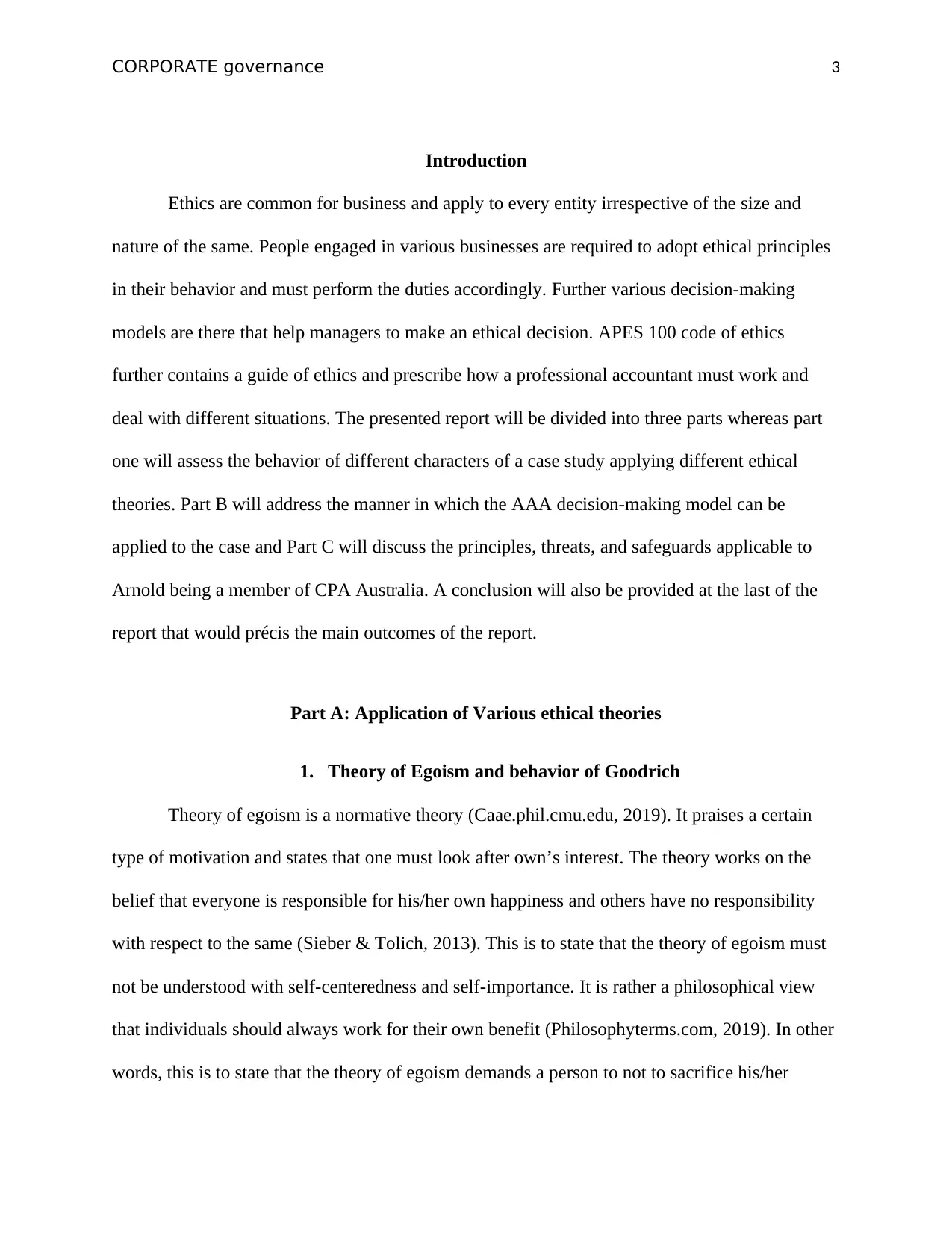
CORPORATE governance 3
Introduction
Ethics are common for business and apply to every entity irrespective of the size and
nature of the same. People engaged in various businesses are required to adopt ethical principles
in their behavior and must perform the duties accordingly. Further various decision-making
models are there that help managers to make an ethical decision. APES 100 code of ethics
further contains a guide of ethics and prescribe how a professional accountant must work and
deal with different situations. The presented report will be divided into three parts whereas part
one will assess the behavior of different characters of a case study applying different ethical
theories. Part B will address the manner in which the AAA decision-making model can be
applied to the case and Part C will discuss the principles, threats, and safeguards applicable to
Arnold being a member of CPA Australia. A conclusion will also be provided at the last of the
report that would précis the main outcomes of the report.
Part A: Application of Various ethical theories
1. Theory of Egoism and behavior of Goodrich
Theory of egoism is a normative theory (Caae.phil.cmu.edu, 2019). It praises a certain
type of motivation and states that one must look after own’s interest. The theory works on the
belief that everyone is responsible for his/her own happiness and others have no responsibility
with respect to the same (Sieber & Tolich, 2013). This is to state that the theory of egoism must
not be understood with self-centeredness and self-importance. It is rather a philosophical view
that individuals should always work for their own benefit (Philosophyterms.com, 2019). In other
words, this is to state that the theory of egoism demands a person to not to sacrifice his/her
Introduction
Ethics are common for business and apply to every entity irrespective of the size and
nature of the same. People engaged in various businesses are required to adopt ethical principles
in their behavior and must perform the duties accordingly. Further various decision-making
models are there that help managers to make an ethical decision. APES 100 code of ethics
further contains a guide of ethics and prescribe how a professional accountant must work and
deal with different situations. The presented report will be divided into three parts whereas part
one will assess the behavior of different characters of a case study applying different ethical
theories. Part B will address the manner in which the AAA decision-making model can be
applied to the case and Part C will discuss the principles, threats, and safeguards applicable to
Arnold being a member of CPA Australia. A conclusion will also be provided at the last of the
report that would précis the main outcomes of the report.
Part A: Application of Various ethical theories
1. Theory of Egoism and behavior of Goodrich
Theory of egoism is a normative theory (Caae.phil.cmu.edu, 2019). It praises a certain
type of motivation and states that one must look after own’s interest. The theory works on the
belief that everyone is responsible for his/her own happiness and others have no responsibility
with respect to the same (Sieber & Tolich, 2013). This is to state that the theory of egoism must
not be understood with self-centeredness and self-importance. It is rather a philosophical view
that individuals should always work for their own benefit (Philosophyterms.com, 2019). In other
words, this is to state that the theory of egoism demands a person to not to sacrifice his/her
Secure Best Marks with AI Grader
Need help grading? Try our AI Grader for instant feedback on your assignments.
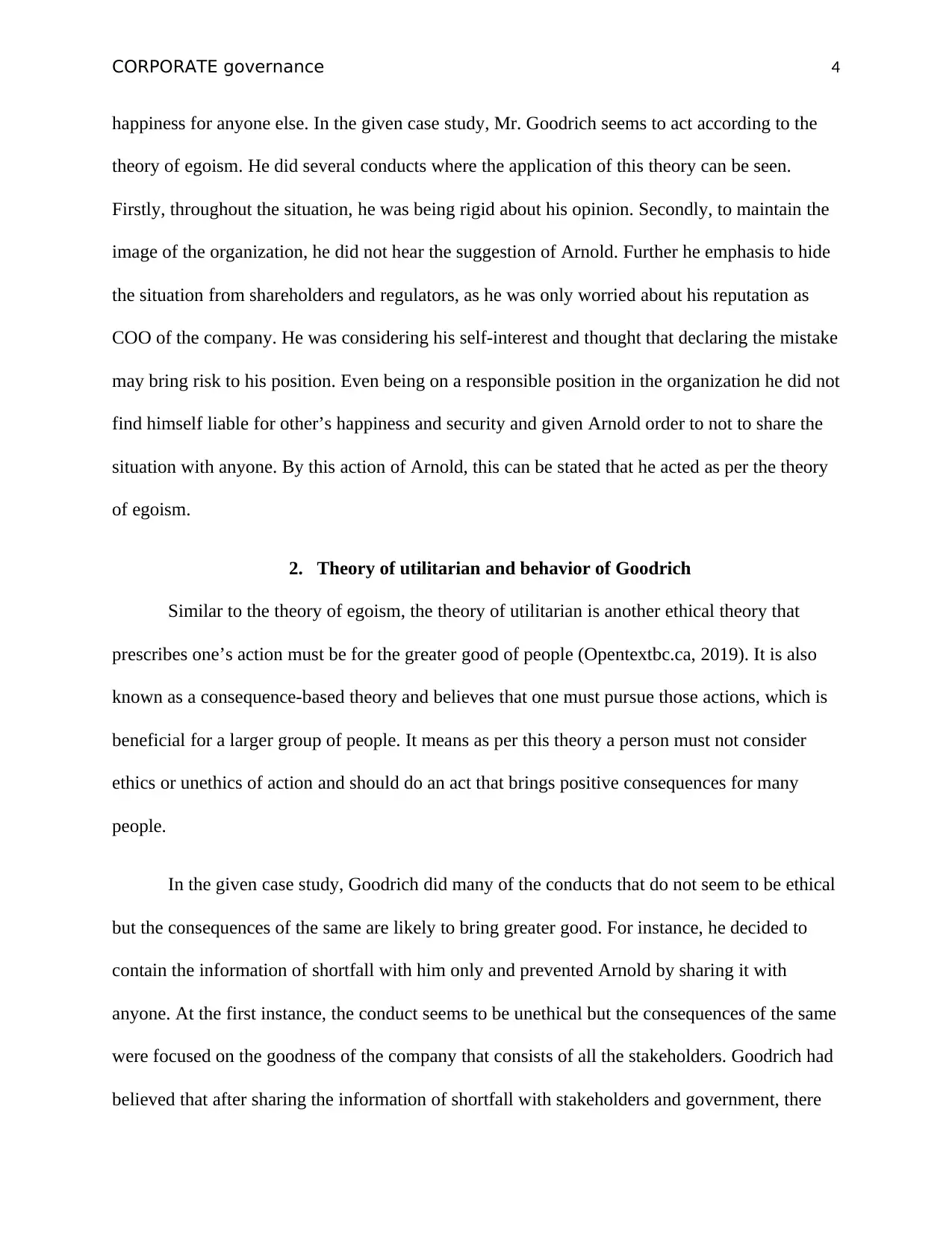
CORPORATE governance 4
happiness for anyone else. In the given case study, Mr. Goodrich seems to act according to the
theory of egoism. He did several conducts where the application of this theory can be seen.
Firstly, throughout the situation, he was being rigid about his opinion. Secondly, to maintain the
image of the organization, he did not hear the suggestion of Arnold. Further he emphasis to hide
the situation from shareholders and regulators, as he was only worried about his reputation as
COO of the company. He was considering his self-interest and thought that declaring the mistake
may bring risk to his position. Even being on a responsible position in the organization he did not
find himself liable for other’s happiness and security and given Arnold order to not to share the
situation with anyone. By this action of Arnold, this can be stated that he acted as per the theory
of egoism.
2. Theory of utilitarian and behavior of Goodrich
Similar to the theory of egoism, the theory of utilitarian is another ethical theory that
prescribes one’s action must be for the greater good of people (Opentextbc.ca, 2019). It is also
known as a consequence-based theory and believes that one must pursue those actions, which is
beneficial for a larger group of people. It means as per this theory a person must not consider
ethics or unethics of action and should do an act that brings positive consequences for many
people.
In the given case study, Goodrich did many of the conducts that do not seem to be ethical
but the consequences of the same are likely to bring greater good. For instance, he decided to
contain the information of shortfall with him only and prevented Arnold by sharing it with
anyone. At the first instance, the conduct seems to be unethical but the consequences of the same
were focused on the goodness of the company that consists of all the stakeholders. Goodrich had
believed that after sharing the information of shortfall with stakeholders and government, there
happiness for anyone else. In the given case study, Mr. Goodrich seems to act according to the
theory of egoism. He did several conducts where the application of this theory can be seen.
Firstly, throughout the situation, he was being rigid about his opinion. Secondly, to maintain the
image of the organization, he did not hear the suggestion of Arnold. Further he emphasis to hide
the situation from shareholders and regulators, as he was only worried about his reputation as
COO of the company. He was considering his self-interest and thought that declaring the mistake
may bring risk to his position. Even being on a responsible position in the organization he did not
find himself liable for other’s happiness and security and given Arnold order to not to share the
situation with anyone. By this action of Arnold, this can be stated that he acted as per the theory
of egoism.
2. Theory of utilitarian and behavior of Goodrich
Similar to the theory of egoism, the theory of utilitarian is another ethical theory that
prescribes one’s action must be for the greater good of people (Opentextbc.ca, 2019). It is also
known as a consequence-based theory and believes that one must pursue those actions, which is
beneficial for a larger group of people. It means as per this theory a person must not consider
ethics or unethics of action and should do an act that brings positive consequences for many
people.
In the given case study, Goodrich did many of the conducts that do not seem to be ethical
but the consequences of the same are likely to bring greater good. For instance, he decided to
contain the information of shortfall with him only and prevented Arnold by sharing it with
anyone. At the first instance, the conduct seems to be unethical but the consequences of the same
were focused on the goodness of the company that consists of all the stakeholders. Goodrich had
believed that after sharing the information of shortfall with stakeholders and government, there
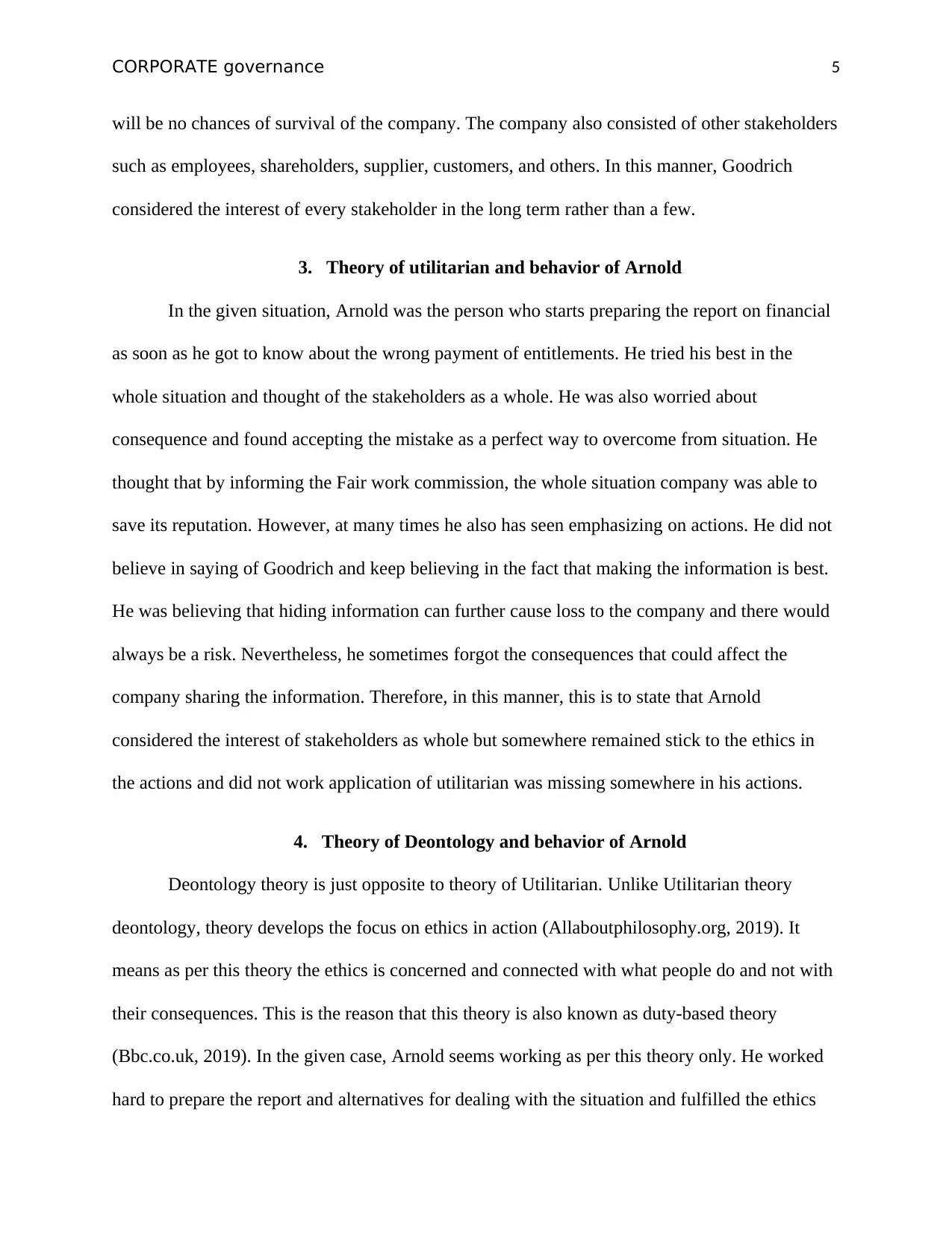
CORPORATE governance 5
will be no chances of survival of the company. The company also consisted of other stakeholders
such as employees, shareholders, supplier, customers, and others. In this manner, Goodrich
considered the interest of every stakeholder in the long term rather than a few.
3. Theory of utilitarian and behavior of Arnold
In the given situation, Arnold was the person who starts preparing the report on financial
as soon as he got to know about the wrong payment of entitlements. He tried his best in the
whole situation and thought of the stakeholders as a whole. He was also worried about
consequence and found accepting the mistake as a perfect way to overcome from situation. He
thought that by informing the Fair work commission, the whole situation company was able to
save its reputation. However, at many times he also has seen emphasizing on actions. He did not
believe in saying of Goodrich and keep believing in the fact that making the information is best.
He was believing that hiding information can further cause loss to the company and there would
always be a risk. Nevertheless, he sometimes forgot the consequences that could affect the
company sharing the information. Therefore, in this manner, this is to state that Arnold
considered the interest of stakeholders as whole but somewhere remained stick to the ethics in
the actions and did not work application of utilitarian was missing somewhere in his actions.
4. Theory of Deontology and behavior of Arnold
Deontology theory is just opposite to theory of Utilitarian. Unlike Utilitarian theory
deontology, theory develops the focus on ethics in action (Allaboutphilosophy.org, 2019). It
means as per this theory the ethics is concerned and connected with what people do and not with
their consequences. This is the reason that this theory is also known as duty-based theory
(Bbc.co.uk, 2019). In the given case, Arnold seems working as per this theory only. He worked
hard to prepare the report and alternatives for dealing with the situation and fulfilled the ethics
will be no chances of survival of the company. The company also consisted of other stakeholders
such as employees, shareholders, supplier, customers, and others. In this manner, Goodrich
considered the interest of every stakeholder in the long term rather than a few.
3. Theory of utilitarian and behavior of Arnold
In the given situation, Arnold was the person who starts preparing the report on financial
as soon as he got to know about the wrong payment of entitlements. He tried his best in the
whole situation and thought of the stakeholders as a whole. He was also worried about
consequence and found accepting the mistake as a perfect way to overcome from situation. He
thought that by informing the Fair work commission, the whole situation company was able to
save its reputation. However, at many times he also has seen emphasizing on actions. He did not
believe in saying of Goodrich and keep believing in the fact that making the information is best.
He was believing that hiding information can further cause loss to the company and there would
always be a risk. Nevertheless, he sometimes forgot the consequences that could affect the
company sharing the information. Therefore, in this manner, this is to state that Arnold
considered the interest of stakeholders as whole but somewhere remained stick to the ethics in
the actions and did not work application of utilitarian was missing somewhere in his actions.
4. Theory of Deontology and behavior of Arnold
Deontology theory is just opposite to theory of Utilitarian. Unlike Utilitarian theory
deontology, theory develops the focus on ethics in action (Allaboutphilosophy.org, 2019). It
means as per this theory the ethics is concerned and connected with what people do and not with
their consequences. This is the reason that this theory is also known as duty-based theory
(Bbc.co.uk, 2019). In the given case, Arnold seems working as per this theory only. He worked
hard to prepare the report and alternatives for dealing with the situation and fulfilled the ethics
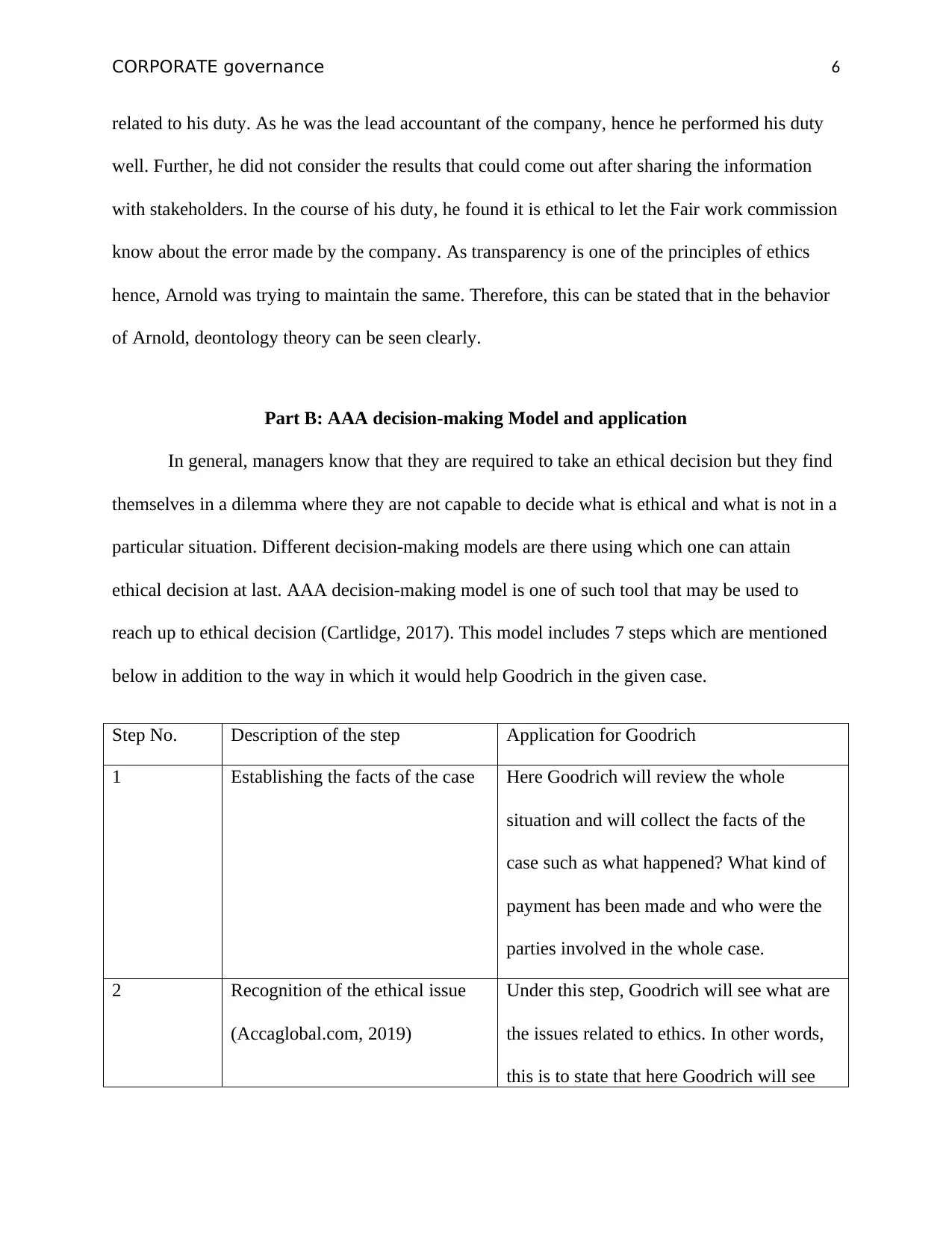
CORPORATE governance 6
related to his duty. As he was the lead accountant of the company, hence he performed his duty
well. Further, he did not consider the results that could come out after sharing the information
with stakeholders. In the course of his duty, he found it is ethical to let the Fair work commission
know about the error made by the company. As transparency is one of the principles of ethics
hence, Arnold was trying to maintain the same. Therefore, this can be stated that in the behavior
of Arnold, deontology theory can be seen clearly.
Part B: AAA decision-making Model and application
In general, managers know that they are required to take an ethical decision but they find
themselves in a dilemma where they are not capable to decide what is ethical and what is not in a
particular situation. Different decision-making models are there using which one can attain
ethical decision at last. AAA decision-making model is one of such tool that may be used to
reach up to ethical decision (Cartlidge, 2017). This model includes 7 steps which are mentioned
below in addition to the way in which it would help Goodrich in the given case.
Step No. Description of the step Application for Goodrich
1 Establishing the facts of the case Here Goodrich will review the whole
situation and will collect the facts of the
case such as what happened? What kind of
payment has been made and who were the
parties involved in the whole case.
2 Recognition of the ethical issue
(Accaglobal.com, 2019)
Under this step, Goodrich will see what are
the issues related to ethics. In other words,
this is to state that here Goodrich will see
related to his duty. As he was the lead accountant of the company, hence he performed his duty
well. Further, he did not consider the results that could come out after sharing the information
with stakeholders. In the course of his duty, he found it is ethical to let the Fair work commission
know about the error made by the company. As transparency is one of the principles of ethics
hence, Arnold was trying to maintain the same. Therefore, this can be stated that in the behavior
of Arnold, deontology theory can be seen clearly.
Part B: AAA decision-making Model and application
In general, managers know that they are required to take an ethical decision but they find
themselves in a dilemma where they are not capable to decide what is ethical and what is not in a
particular situation. Different decision-making models are there using which one can attain
ethical decision at last. AAA decision-making model is one of such tool that may be used to
reach up to ethical decision (Cartlidge, 2017). This model includes 7 steps which are mentioned
below in addition to the way in which it would help Goodrich in the given case.
Step No. Description of the step Application for Goodrich
1 Establishing the facts of the case Here Goodrich will review the whole
situation and will collect the facts of the
case such as what happened? What kind of
payment has been made and who were the
parties involved in the whole case.
2 Recognition of the ethical issue
(Accaglobal.com, 2019)
Under this step, Goodrich will see what are
the issues related to ethics. In other words,
this is to state that here Goodrich will see
Paraphrase This Document
Need a fresh take? Get an instant paraphrase of this document with our AI Paraphraser
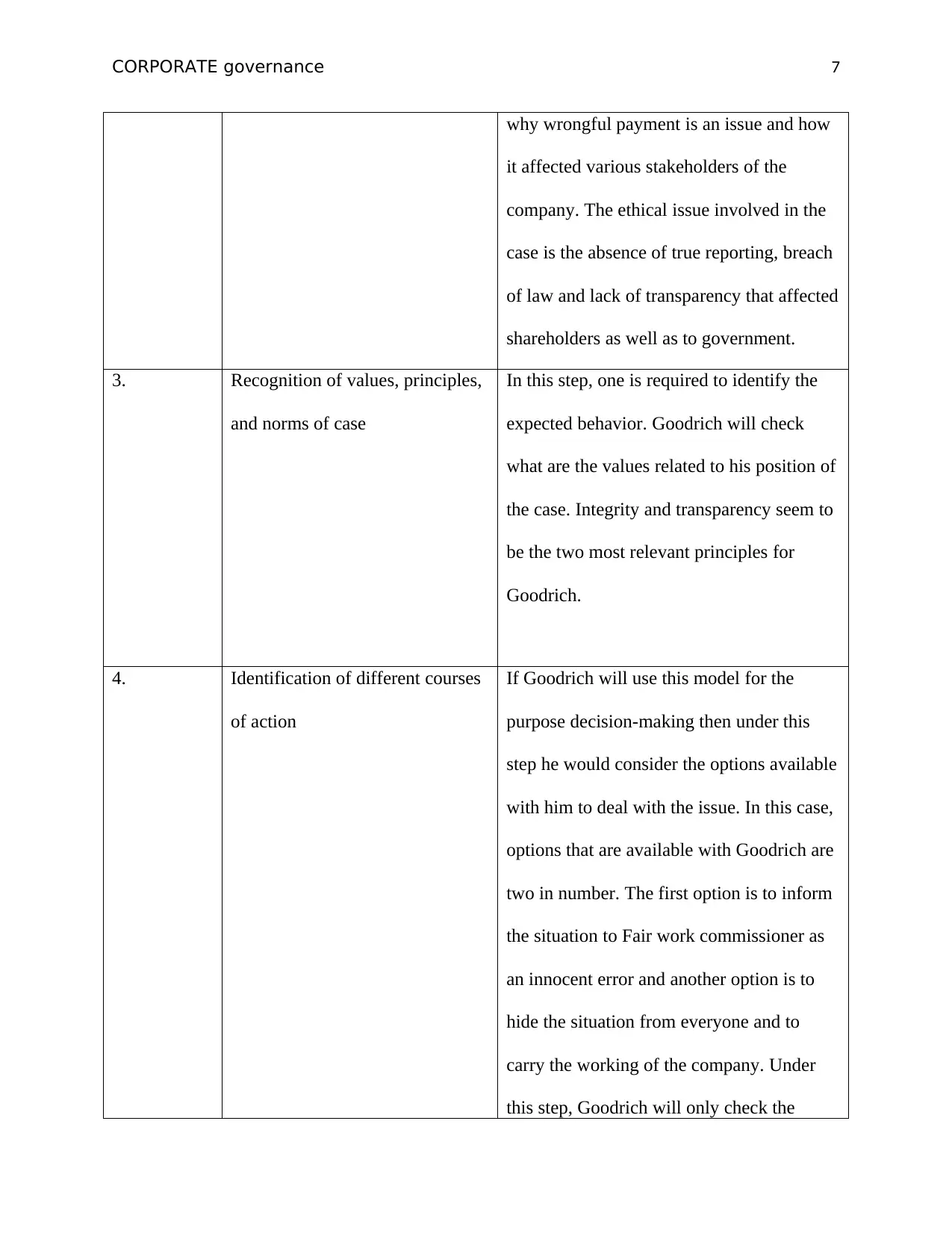
CORPORATE governance 7
why wrongful payment is an issue and how
it affected various stakeholders of the
company. The ethical issue involved in the
case is the absence of true reporting, breach
of law and lack of transparency that affected
shareholders as well as to government.
3. Recognition of values, principles,
and norms of case
In this step, one is required to identify the
expected behavior. Goodrich will check
what are the values related to his position of
the case. Integrity and transparency seem to
be the two most relevant principles for
Goodrich.
4. Identification of different courses
of action
If Goodrich will use this model for the
purpose decision-making then under this
step he would consider the options available
with him to deal with the issue. In this case,
options that are available with Goodrich are
two in number. The first option is to inform
the situation to Fair work commissioner as
an innocent error and another option is to
hide the situation from everyone and to
carry the working of the company. Under
this step, Goodrich will only check the
why wrongful payment is an issue and how
it affected various stakeholders of the
company. The ethical issue involved in the
case is the absence of true reporting, breach
of law and lack of transparency that affected
shareholders as well as to government.
3. Recognition of values, principles,
and norms of case
In this step, one is required to identify the
expected behavior. Goodrich will check
what are the values related to his position of
the case. Integrity and transparency seem to
be the two most relevant principles for
Goodrich.
4. Identification of different courses
of action
If Goodrich will use this model for the
purpose decision-making then under this
step he would consider the options available
with him to deal with the issue. In this case,
options that are available with Goodrich are
two in number. The first option is to inform
the situation to Fair work commissioner as
an innocent error and another option is to
hide the situation from everyone and to
carry the working of the company. Under
this step, Goodrich will only check the
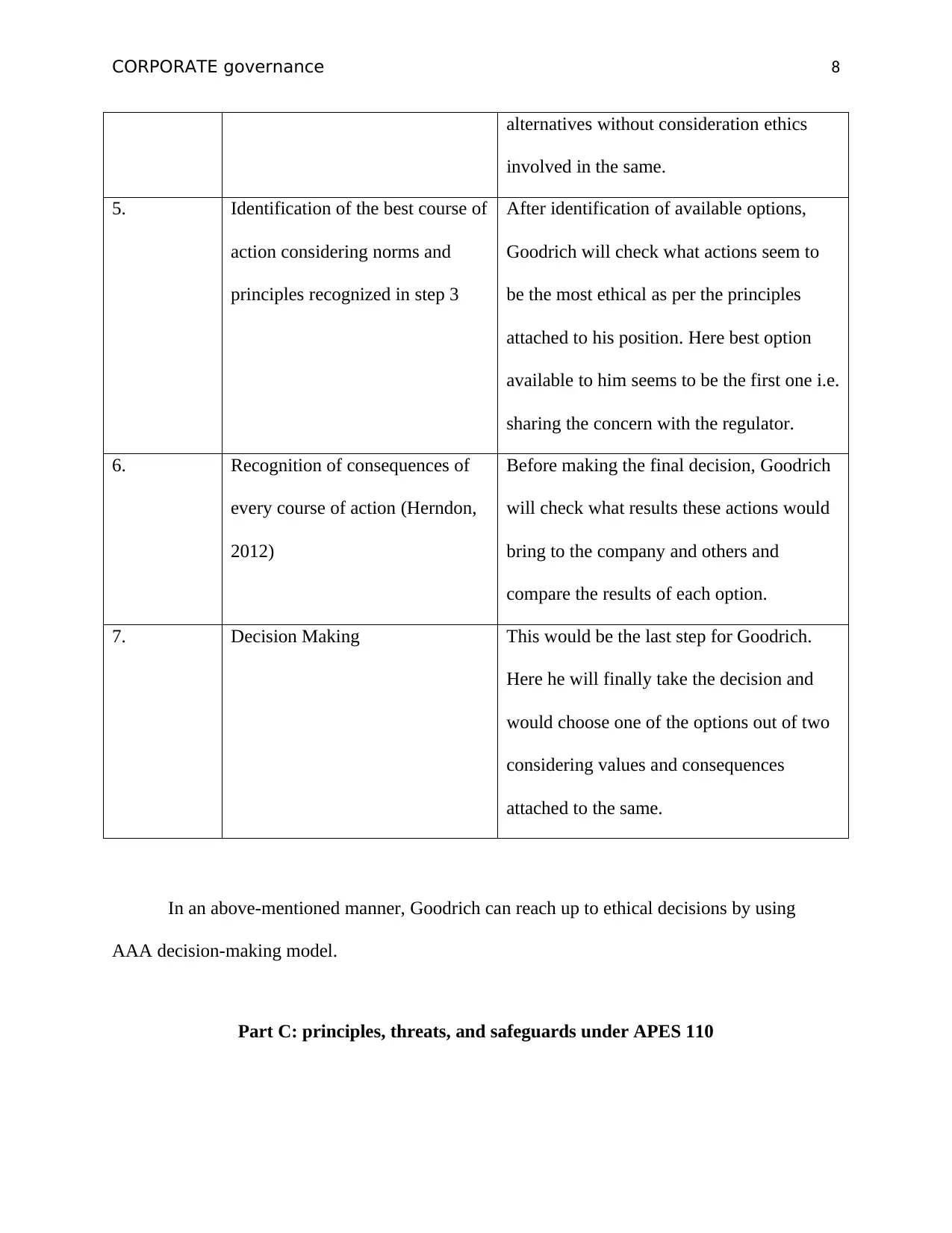
CORPORATE governance 8
alternatives without consideration ethics
involved in the same.
5. Identification of the best course of
action considering norms and
principles recognized in step 3
After identification of available options,
Goodrich will check what actions seem to
be the most ethical as per the principles
attached to his position. Here best option
available to him seems to be the first one i.e.
sharing the concern with the regulator.
6. Recognition of consequences of
every course of action (Herndon,
2012)
Before making the final decision, Goodrich
will check what results these actions would
bring to the company and others and
compare the results of each option.
7. Decision Making This would be the last step for Goodrich.
Here he will finally take the decision and
would choose one of the options out of two
considering values and consequences
attached to the same.
In an above-mentioned manner, Goodrich can reach up to ethical decisions by using
AAA decision-making model.
Part C: principles, threats, and safeguards under APES 110
alternatives without consideration ethics
involved in the same.
5. Identification of the best course of
action considering norms and
principles recognized in step 3
After identification of available options,
Goodrich will check what actions seem to
be the most ethical as per the principles
attached to his position. Here best option
available to him seems to be the first one i.e.
sharing the concern with the regulator.
6. Recognition of consequences of
every course of action (Herndon,
2012)
Before making the final decision, Goodrich
will check what results these actions would
bring to the company and others and
compare the results of each option.
7. Decision Making This would be the last step for Goodrich.
Here he will finally take the decision and
would choose one of the options out of two
considering values and consequences
attached to the same.
In an above-mentioned manner, Goodrich can reach up to ethical decisions by using
AAA decision-making model.
Part C: principles, threats, and safeguards under APES 110
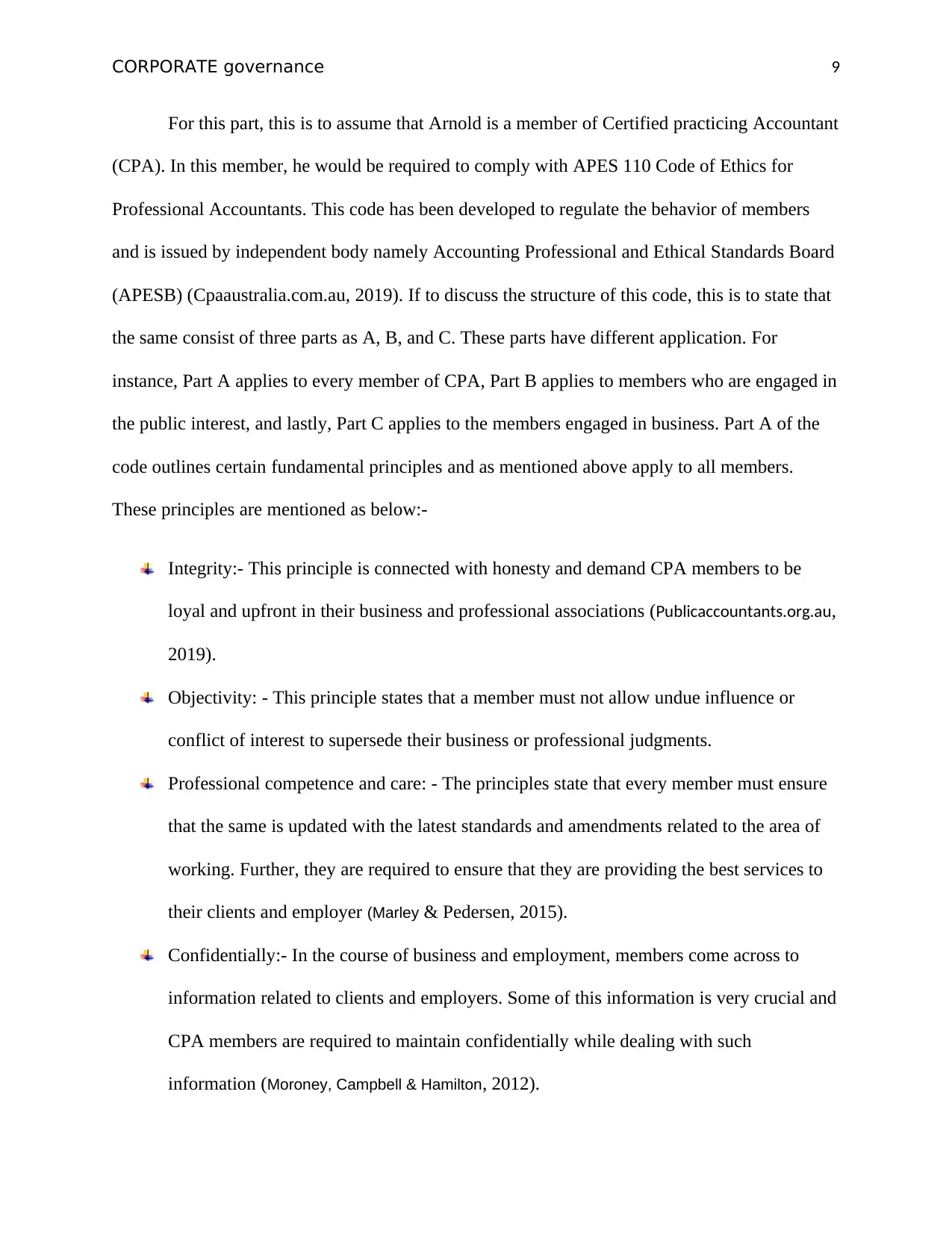
CORPORATE governance 9
For this part, this is to assume that Arnold is a member of Certified practicing Accountant
(CPA). In this member, he would be required to comply with APES 110 Code of Ethics for
Professional Accountants. This code has been developed to regulate the behavior of members
and is issued by independent body namely Accounting Professional and Ethical Standards Board
(APESB) (Cpaaustralia.com.au, 2019). If to discuss the structure of this code, this is to state that
the same consist of three parts as A, B, and C. These parts have different application. For
instance, Part A applies to every member of CPA, Part B applies to members who are engaged in
the public interest, and lastly, Part C applies to the members engaged in business. Part A of the
code outlines certain fundamental principles and as mentioned above apply to all members.
These principles are mentioned as below:-
Integrity:- This principle is connected with honesty and demand CPA members to be
loyal and upfront in their business and professional associations (Publicaccountants.org.au,
2019).
Objectivity: - This principle states that a member must not allow undue influence or
conflict of interest to supersede their business or professional judgments.
Professional competence and care: - The principles state that every member must ensure
that the same is updated with the latest standards and amendments related to the area of
working. Further, they are required to ensure that they are providing the best services to
their clients and employer (Marley & Pedersen, 2015).
Confidentially:- In the course of business and employment, members come across to
information related to clients and employers. Some of this information is very crucial and
CPA members are required to maintain confidentially while dealing with such
information (Moroney, Campbell & Hamilton, 2012).
For this part, this is to assume that Arnold is a member of Certified practicing Accountant
(CPA). In this member, he would be required to comply with APES 110 Code of Ethics for
Professional Accountants. This code has been developed to regulate the behavior of members
and is issued by independent body namely Accounting Professional and Ethical Standards Board
(APESB) (Cpaaustralia.com.au, 2019). If to discuss the structure of this code, this is to state that
the same consist of three parts as A, B, and C. These parts have different application. For
instance, Part A applies to every member of CPA, Part B applies to members who are engaged in
the public interest, and lastly, Part C applies to the members engaged in business. Part A of the
code outlines certain fundamental principles and as mentioned above apply to all members.
These principles are mentioned as below:-
Integrity:- This principle is connected with honesty and demand CPA members to be
loyal and upfront in their business and professional associations (Publicaccountants.org.au,
2019).
Objectivity: - This principle states that a member must not allow undue influence or
conflict of interest to supersede their business or professional judgments.
Professional competence and care: - The principles state that every member must ensure
that the same is updated with the latest standards and amendments related to the area of
working. Further, they are required to ensure that they are providing the best services to
their clients and employer (Marley & Pedersen, 2015).
Confidentially:- In the course of business and employment, members come across to
information related to clients and employers. Some of this information is very crucial and
CPA members are required to maintain confidentially while dealing with such
information (Moroney, Campbell & Hamilton, 2012).
Secure Best Marks with AI Grader
Need help grading? Try our AI Grader for instant feedback on your assignments.
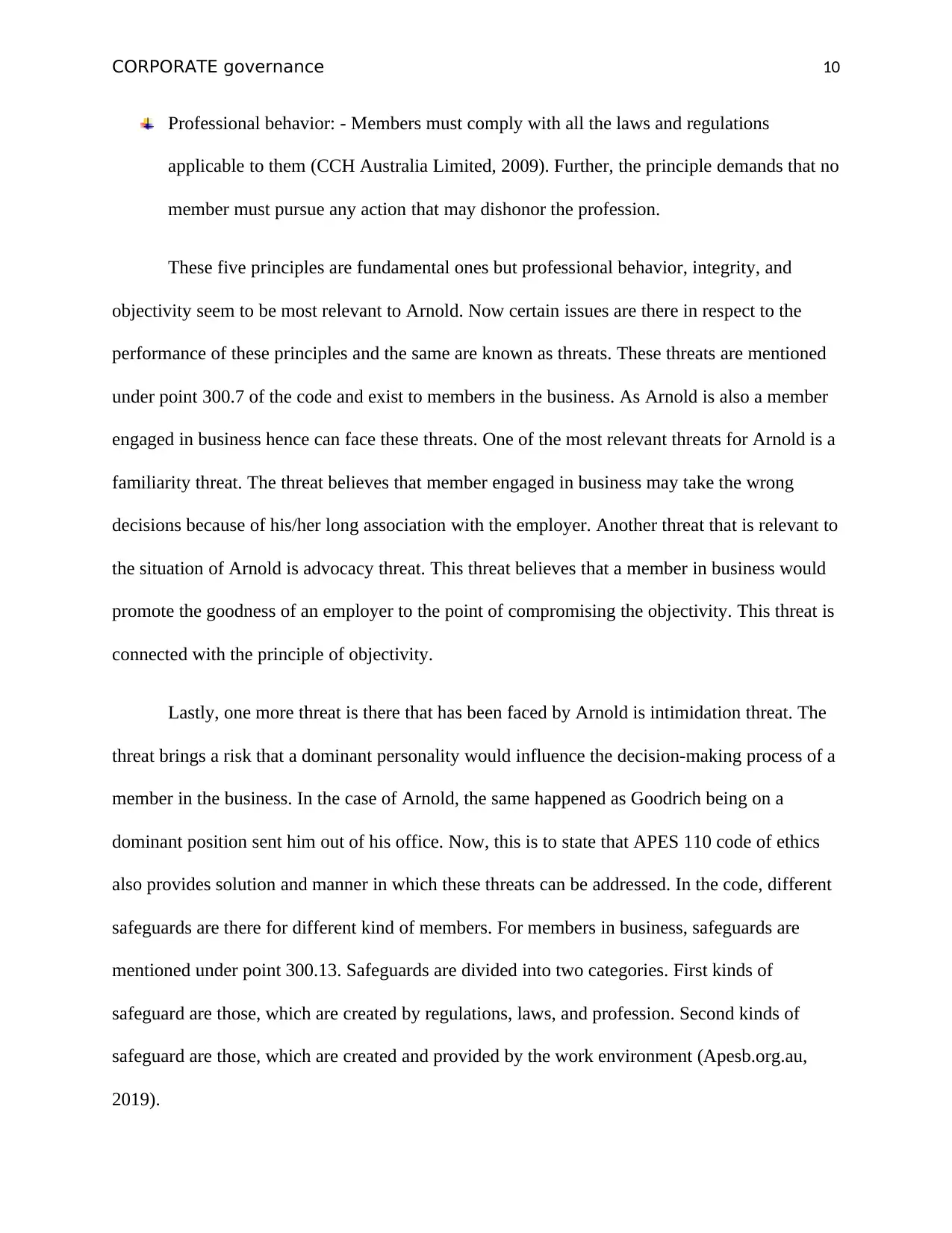
CORPORATE governance 10
Professional behavior: - Members must comply with all the laws and regulations
applicable to them (CCH Australia Limited, 2009). Further, the principle demands that no
member must pursue any action that may dishonor the profession.
These five principles are fundamental ones but professional behavior, integrity, and
objectivity seem to be most relevant to Arnold. Now certain issues are there in respect to the
performance of these principles and the same are known as threats. These threats are mentioned
under point 300.7 of the code and exist to members in the business. As Arnold is also a member
engaged in business hence can face these threats. One of the most relevant threats for Arnold is a
familiarity threat. The threat believes that member engaged in business may take the wrong
decisions because of his/her long association with the employer. Another threat that is relevant to
the situation of Arnold is advocacy threat. This threat believes that a member in business would
promote the goodness of an employer to the point of compromising the objectivity. This threat is
connected with the principle of objectivity.
Lastly, one more threat is there that has been faced by Arnold is intimidation threat. The
threat brings a risk that a dominant personality would influence the decision-making process of a
member in the business. In the case of Arnold, the same happened as Goodrich being on a
dominant position sent him out of his office. Now, this is to state that APES 110 code of ethics
also provides solution and manner in which these threats can be addressed. In the code, different
safeguards are there for different kind of members. For members in business, safeguards are
mentioned under point 300.13. Safeguards are divided into two categories. First kinds of
safeguard are those, which are created by regulations, laws, and profession. Second kinds of
safeguard are those, which are created and provided by the work environment (Apesb.org.au,
2019).
Professional behavior: - Members must comply with all the laws and regulations
applicable to them (CCH Australia Limited, 2009). Further, the principle demands that no
member must pursue any action that may dishonor the profession.
These five principles are fundamental ones but professional behavior, integrity, and
objectivity seem to be most relevant to Arnold. Now certain issues are there in respect to the
performance of these principles and the same are known as threats. These threats are mentioned
under point 300.7 of the code and exist to members in the business. As Arnold is also a member
engaged in business hence can face these threats. One of the most relevant threats for Arnold is a
familiarity threat. The threat believes that member engaged in business may take the wrong
decisions because of his/her long association with the employer. Another threat that is relevant to
the situation of Arnold is advocacy threat. This threat believes that a member in business would
promote the goodness of an employer to the point of compromising the objectivity. This threat is
connected with the principle of objectivity.
Lastly, one more threat is there that has been faced by Arnold is intimidation threat. The
threat brings a risk that a dominant personality would influence the decision-making process of a
member in the business. In the case of Arnold, the same happened as Goodrich being on a
dominant position sent him out of his office. Now, this is to state that APES 110 code of ethics
also provides solution and manner in which these threats can be addressed. In the code, different
safeguards are there for different kind of members. For members in business, safeguards are
mentioned under point 300.13. Safeguards are divided into two categories. First kinds of
safeguard are those, which are created by regulations, laws, and profession. Second kinds of
safeguard are those, which are created and provided by the work environment (Apesb.org.au,
2019).
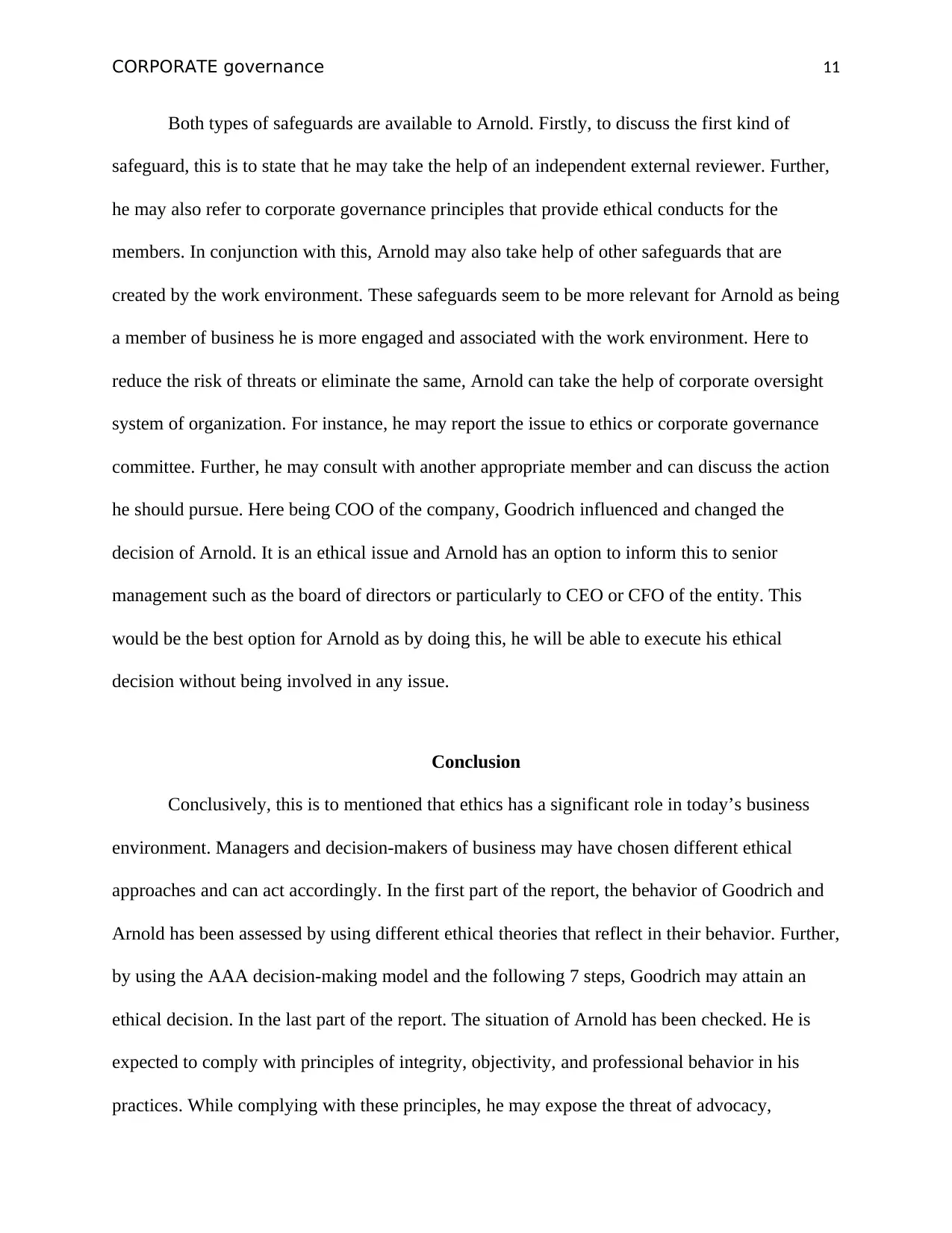
CORPORATE governance 11
Both types of safeguards are available to Arnold. Firstly, to discuss the first kind of
safeguard, this is to state that he may take the help of an independent external reviewer. Further,
he may also refer to corporate governance principles that provide ethical conducts for the
members. In conjunction with this, Arnold may also take help of other safeguards that are
created by the work environment. These safeguards seem to be more relevant for Arnold as being
a member of business he is more engaged and associated with the work environment. Here to
reduce the risk of threats or eliminate the same, Arnold can take the help of corporate oversight
system of organization. For instance, he may report the issue to ethics or corporate governance
committee. Further, he may consult with another appropriate member and can discuss the action
he should pursue. Here being COO of the company, Goodrich influenced and changed the
decision of Arnold. It is an ethical issue and Arnold has an option to inform this to senior
management such as the board of directors or particularly to CEO or CFO of the entity. This
would be the best option for Arnold as by doing this, he will be able to execute his ethical
decision without being involved in any issue.
Conclusion
Conclusively, this is to mentioned that ethics has a significant role in today’s business
environment. Managers and decision-makers of business may have chosen different ethical
approaches and can act accordingly. In the first part of the report, the behavior of Goodrich and
Arnold has been assessed by using different ethical theories that reflect in their behavior. Further,
by using the AAA decision-making model and the following 7 steps, Goodrich may attain an
ethical decision. In the last part of the report. The situation of Arnold has been checked. He is
expected to comply with principles of integrity, objectivity, and professional behavior in his
practices. While complying with these principles, he may expose the threat of advocacy,
Both types of safeguards are available to Arnold. Firstly, to discuss the first kind of
safeguard, this is to state that he may take the help of an independent external reviewer. Further,
he may also refer to corporate governance principles that provide ethical conducts for the
members. In conjunction with this, Arnold may also take help of other safeguards that are
created by the work environment. These safeguards seem to be more relevant for Arnold as being
a member of business he is more engaged and associated with the work environment. Here to
reduce the risk of threats or eliminate the same, Arnold can take the help of corporate oversight
system of organization. For instance, he may report the issue to ethics or corporate governance
committee. Further, he may consult with another appropriate member and can discuss the action
he should pursue. Here being COO of the company, Goodrich influenced and changed the
decision of Arnold. It is an ethical issue and Arnold has an option to inform this to senior
management such as the board of directors or particularly to CEO or CFO of the entity. This
would be the best option for Arnold as by doing this, he will be able to execute his ethical
decision without being involved in any issue.
Conclusion
Conclusively, this is to mentioned that ethics has a significant role in today’s business
environment. Managers and decision-makers of business may have chosen different ethical
approaches and can act accordingly. In the first part of the report, the behavior of Goodrich and
Arnold has been assessed by using different ethical theories that reflect in their behavior. Further,
by using the AAA decision-making model and the following 7 steps, Goodrich may attain an
ethical decision. In the last part of the report. The situation of Arnold has been checked. He is
expected to comply with principles of integrity, objectivity, and professional behavior in his
practices. While complying with these principles, he may expose the threat of advocacy,
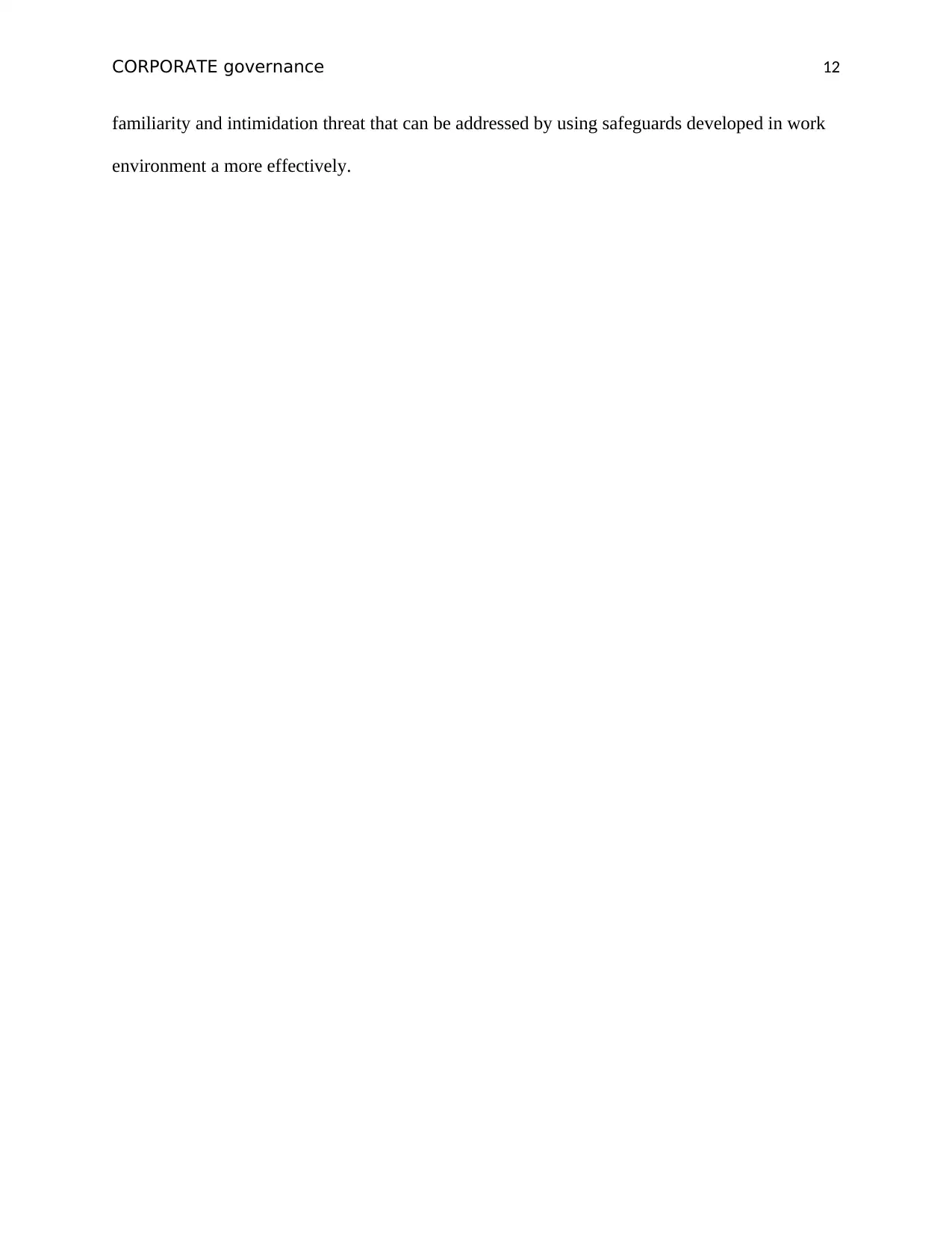
CORPORATE governance 12
familiarity and intimidation threat that can be addressed by using safeguards developed in work
environment a more effectively.
familiarity and intimidation threat that can be addressed by using safeguards developed in work
environment a more effectively.
Paraphrase This Document
Need a fresh take? Get an instant paraphrase of this document with our AI Paraphraser
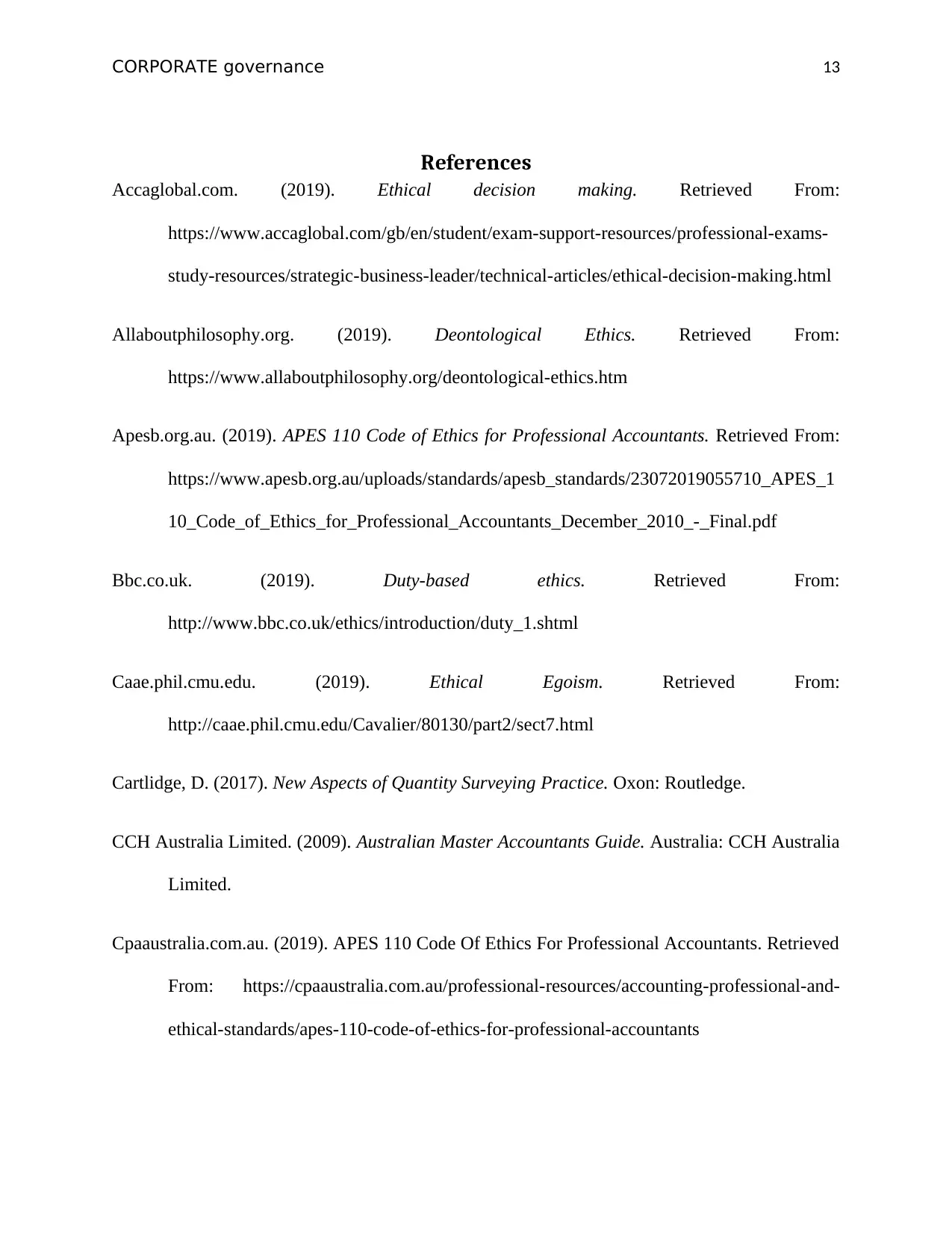
CORPORATE governance 13
References
Accaglobal.com. (2019). Ethical decision making. Retrieved From:
https://www.accaglobal.com/gb/en/student/exam-support-resources/professional-exams-
study-resources/strategic-business-leader/technical-articles/ethical-decision-making.html
Allaboutphilosophy.org. (2019). Deontological Ethics. Retrieved From:
https://www.allaboutphilosophy.org/deontological-ethics.htm
Apesb.org.au. (2019). APES 110 Code of Ethics for Professional Accountants. Retrieved From:
https://www.apesb.org.au/uploads/standards/apesb_standards/23072019055710_APES_1
10_Code_of_Ethics_for_Professional_Accountants_December_2010_-_Final.pdf
Bbc.co.uk. (2019). Duty-based ethics. Retrieved From:
http://www.bbc.co.uk/ethics/introduction/duty_1.shtml
Caae.phil.cmu.edu. (2019). Ethical Egoism. Retrieved From:
http://caae.phil.cmu.edu/Cavalier/80130/part2/sect7.html
Cartlidge, D. (2017). New Aspects of Quantity Surveying Practice. Oxon: Routledge.
CCH Australia Limited. (2009). Australian Master Accountants Guide. Australia: CCH Australia
Limited.
Cpaaustralia.com.au. (2019). APES 110 Code Of Ethics For Professional Accountants. Retrieved
From: https://cpaaustralia.com.au/professional-resources/accounting-professional-and-
ethical-standards/apes-110-code-of-ethics-for-professional-accountants
References
Accaglobal.com. (2019). Ethical decision making. Retrieved From:
https://www.accaglobal.com/gb/en/student/exam-support-resources/professional-exams-
study-resources/strategic-business-leader/technical-articles/ethical-decision-making.html
Allaboutphilosophy.org. (2019). Deontological Ethics. Retrieved From:
https://www.allaboutphilosophy.org/deontological-ethics.htm
Apesb.org.au. (2019). APES 110 Code of Ethics for Professional Accountants. Retrieved From:
https://www.apesb.org.au/uploads/standards/apesb_standards/23072019055710_APES_1
10_Code_of_Ethics_for_Professional_Accountants_December_2010_-_Final.pdf
Bbc.co.uk. (2019). Duty-based ethics. Retrieved From:
http://www.bbc.co.uk/ethics/introduction/duty_1.shtml
Caae.phil.cmu.edu. (2019). Ethical Egoism. Retrieved From:
http://caae.phil.cmu.edu/Cavalier/80130/part2/sect7.html
Cartlidge, D. (2017). New Aspects of Quantity Surveying Practice. Oxon: Routledge.
CCH Australia Limited. (2009). Australian Master Accountants Guide. Australia: CCH Australia
Limited.
Cpaaustralia.com.au. (2019). APES 110 Code Of Ethics For Professional Accountants. Retrieved
From: https://cpaaustralia.com.au/professional-resources/accounting-professional-and-
ethical-standards/apes-110-code-of-ethics-for-professional-accountants
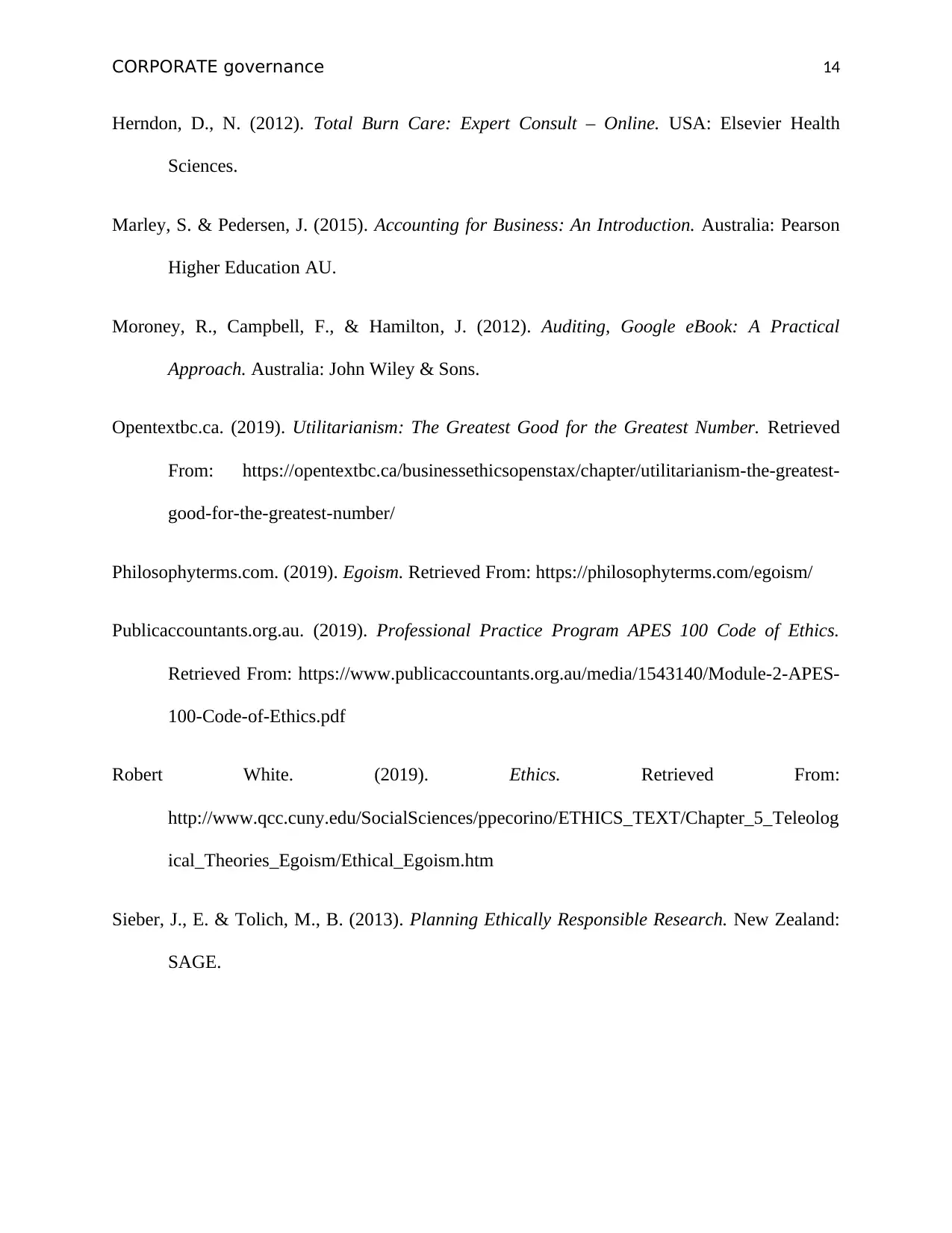
CORPORATE governance 14
Herndon, D., N. (2012). Total Burn Care: Expert Consult – Online. USA: Elsevier Health
Sciences.
Marley, S. & Pedersen, J. (2015). Accounting for Business: An Introduction. Australia: Pearson
Higher Education AU.
Moroney, R., Campbell, F., & Hamilton, J. (2012). Auditing, Google eBook: A Practical
Approach. Australia: John Wiley & Sons.
Opentextbc.ca. (2019). Utilitarianism: The Greatest Good for the Greatest Number. Retrieved
From: https://opentextbc.ca/businessethicsopenstax/chapter/utilitarianism-the-greatest-
good-for-the-greatest-number/
Philosophyterms.com. (2019). Egoism. Retrieved From: https://philosophyterms.com/egoism/
Publicaccountants.org.au. (2019). Professional Practice Program APES 100 Code of Ethics.
Retrieved From: https://www.publicaccountants.org.au/media/1543140/Module-2-APES-
100-Code-of-Ethics.pdf
Robert White. (2019). Ethics. Retrieved From:
http://www.qcc.cuny.edu/SocialSciences/ppecorino/ETHICS_TEXT/Chapter_5_Teleolog
ical_Theories_Egoism/Ethical_Egoism.htm
Sieber, J., E. & Tolich, M., B. (2013). Planning Ethically Responsible Research. New Zealand:
SAGE.
Herndon, D., N. (2012). Total Burn Care: Expert Consult – Online. USA: Elsevier Health
Sciences.
Marley, S. & Pedersen, J. (2015). Accounting for Business: An Introduction. Australia: Pearson
Higher Education AU.
Moroney, R., Campbell, F., & Hamilton, J. (2012). Auditing, Google eBook: A Practical
Approach. Australia: John Wiley & Sons.
Opentextbc.ca. (2019). Utilitarianism: The Greatest Good for the Greatest Number. Retrieved
From: https://opentextbc.ca/businessethicsopenstax/chapter/utilitarianism-the-greatest-
good-for-the-greatest-number/
Philosophyterms.com. (2019). Egoism. Retrieved From: https://philosophyterms.com/egoism/
Publicaccountants.org.au. (2019). Professional Practice Program APES 100 Code of Ethics.
Retrieved From: https://www.publicaccountants.org.au/media/1543140/Module-2-APES-
100-Code-of-Ethics.pdf
Robert White. (2019). Ethics. Retrieved From:
http://www.qcc.cuny.edu/SocialSciences/ppecorino/ETHICS_TEXT/Chapter_5_Teleolog
ical_Theories_Egoism/Ethical_Egoism.htm
Sieber, J., E. & Tolich, M., B. (2013). Planning Ethically Responsible Research. New Zealand:
SAGE.
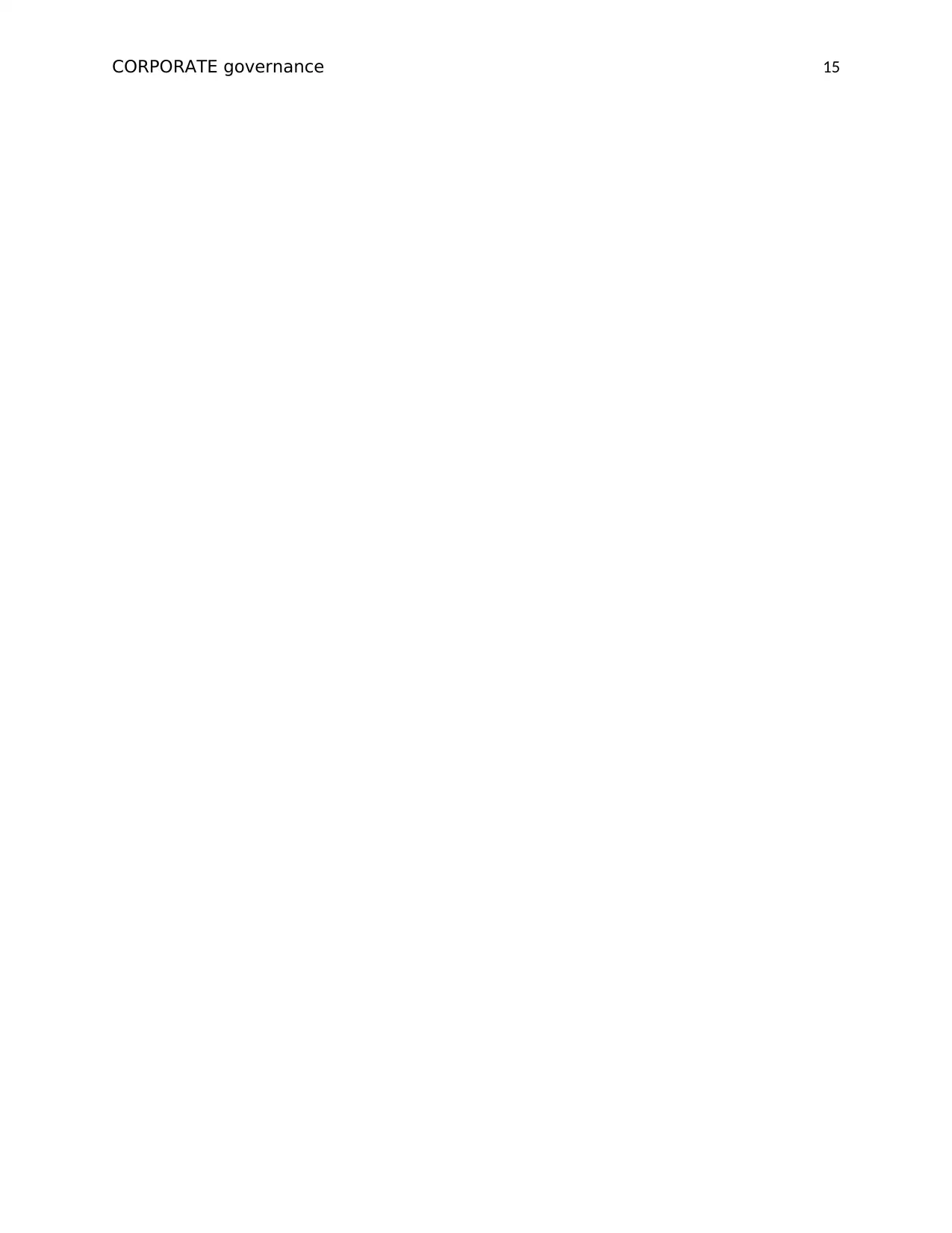
CORPORATE governance 15
1 out of 16
Related Documents
Your All-in-One AI-Powered Toolkit for Academic Success.
+13062052269
info@desklib.com
Available 24*7 on WhatsApp / Email
![[object Object]](/_next/static/media/star-bottom.7253800d.svg)
Unlock your academic potential
© 2024 | Zucol Services PVT LTD | All rights reserved.





